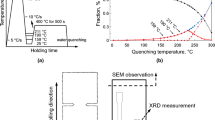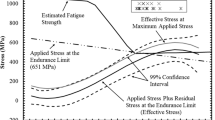Abstract
Fracture toughness was studied in terms of crack-tip opening displacement (CTOD) in low-C medium-Mn high-strength steel at both room temperature and − 40 °C, and excellent fracture toughness was obtained. The critical CTOD values (δ) and crack extension (∆a) followed the relationship: δ = 0.01343 + 0.62315∆a0.47531 and δ = 0.07391 + 0.48466∆a0.60103 at room temperature and − 40 °C, respectively. With the decrease in test temperature from room temperature to − 40 °C, the corresponding δ when ∆a = 0.2 mm (δ0.2) was reduced from 0.30341 to 0.25813 mm, and intersecting point in the crack extension resistance curve with a 0.2-mm passivation line (δQ0.2BL) was reduced from 0.42132 to 0.33941 mm. The large fraction of high misorientation boundaries between tempered martensite effectively hindered the crack propagation and increased the fracture toughness. Furthermore, the submicron-scale complex laminated microstructure of tempered martensite and reversed austenite refined the effective fracture grain size, which inhibited crack propagation and led to high fracture toughness. Also, the excellent fracture toughness is attributed to strain-induced martensite transformation of reversed austenite in the small plastic deformation zone ahead of the crack tip, which absorbed the strain energy, relaxed the local stress concentration, suppressed the crack propagation, and enhanced the fracture toughness.








Similar content being viewed by others
References
Han J, Nam JH, Lee YK (2016) The mechanism of hydrogen embrittlement in intercritically annealed medium Mn TRIP steel. Acta Mater 113:1–10
Hu J, Du LX, Xu W, Zhai JH, Dong Y, Liu YJ, Misra RDK (2018) Ensuring combination of strength, ductility and toughness in medium-manganese steel through optimization of nano-scale metastable austenite. Mater Charact 136:20–28
Sun C, Liu SL, Misra RDK, Li Q, Li DH (2018) Influence of intercritical tempering temperature on impact toughness of a quenched and tempered medium-Mn steel: intercritical tempering versus traditional tempering. Mater Sci Eng A 711:484–491
Chen J, Zhang WN, Liu ZY, Wang GD (2017) The role of retained austenite on the mechanical properties of a low carbon 3Mn–1.5Ni Steel. Metall Mater Trans A 48:5849–5859
Chen J, Lv MY, Liu ZY, Wang GD (2015) Combination of ductility and toughness by the design of fine ferrite/tempered martensite–austenite microstructure in a low carbon medium manganese alloyed steel plate. Mater Sci Eng A 648:51–56
Zhu XK, Joyce JA (2012) Review of fracture toughness (G, K, J, CTOD, CTOA) testing and standardization. Eng Fract Mech 85:1–46
Iwamoto T, Tsuta T (2002) Computational simulation on deformation behavior of CT specimens of TRIP steel under mode I loading for evaluation of fracture toughness. Int J Plast 18:1583–1606
Wells AA (1963) Application of fracture mechanics at and beyond general yielding. Br Weld J 10:563–570
Newman JC Jr, James MA, Zerbst U (2003) A review of the CTOA/CTOD fracture criterion. Eng Fract Mech 70:371–385
Chen JJ, Jiang LW, Huang Y (2017) A quantitative study on the influence of compressive stress on crack-tip opening displacement. Ocean Eng 143:140–148
GB/T 21143-2014 (2014) Metallic materials-Unified method of test for determination of quasistatic fracture toughness
Sugimoto K, Usui N, Kobayashi M, Hashimoto S (1992) Effects of volume fraction and stability of retained austenite on ductility of TRIP-aided dual-phase steels. ISIJ Int 32:1311–1318
Lee SJ, Lee S, De Cooman BC (2011) Mn partitioning during the intercritical annealing of ultrafine-grained 6% Mn transformation-induced plasticity steel. Scr Mater 64:649–652
Hu J, Du LX, Liu H, Sun GS, Xie H, Yi HL, Misra RDK (2015) Structure-mechanical property relationship in a low-C medium-Mn ultrahigh strength heavy plate steel with austenite-martensite submicro-laminate structure. Mater Sci Eng A 647:144–151
Qiu H, Wang LN, Qi JG, Zou H, Hiraoka K (2013) Enhancement of fracture toughness of high-strength Cr–Ni weld metals by strain-induced martensite transformation. Mater Sci Eng A 579:71–76
Miihkinen VTT, Edmonds DV (1984) Influence of retained austenite on the fracture toughness of high strength steel. Fracture 2:1481–1487
Miihkinen VTT, Edmonds DV (1987) Fracture toughness of two experimental high-strength bainitic low-alloy steels containing silicon. Mater Sci Technol 3:441–449
Earl RP, Victor FZ (1975) Microstructural features affecting fracture toughness of high strength steel. Eng Fract Mech 7:371–375
Wang CC, Zhang C, Yang ZG, Su J, Weng YQ (2015) Analysis of fracture toughness in high Co–Ni secondary hardening steel using FEM. Mater Sci Eng A 646:1–7
Zou Y, Xu YB, Hu ZP, Gu XL, Peng F, Tan XD, Chen SQ, Han DT (2016) Austenite stability and its effect on the toughness of a high strength ultra-low carbon medium manganese steel plate. Mater Sci Eng A 675:153–163
Liu H, Du LX, Hu J, Wu HY, Gao XH, Misra RDK (2017) Interplay between reversed austenite and plastic deformation in a directly quenched and intercritically annealed 0.04C–5Mn low-Al steel. J Alloys Compd 695:2072–2082
Sakuzna Y, Matlock DK, Krauss G (1992) Interciiticaliy annealed and isothermally transformed 0.15Pct C steel containing 1.2Pct Si–1.5Pct Mn and 4Pct Ni: part II. Effect of testing temperature on stress-strain behavior and deformation-induced austenite transformation. Metall Trans 42:1233–1241
Huo CY, Gao HL (2005) Strain-induced martensitic transformation in fatigue crack tip zone for a high strength steel. Mater Charact 55:12–18
Qi XY, Du LX, Hu J, Misra RDK (2018) High-cycle fatigue behavior of low-C medium-Mn high strength steel with austenite-martensite submicron-sized lath-like structure. Mater Sci Eng A 718:477–482
Antolovich SD, Singh B (1971) On the toughness increment associated with the austenite to martensite phase transformation in TRIP steels. Metall Mater Trans B 2:2135–2141
Nakanishi D, Kawabata T, Aihara S (2018) Effect of dispersed retained γ-Fe on brittle crack arrest toughness in 9% Ni steel in cryogenic temperatures. Mater Sci Eng A 723:238–246
Parker ER, Zackay VF (1973) Enhancement of fracture toughness in high strength steel by microstructural control. Eng Fract Mech 5:147–165
Hallberg H, Banks-Sills L, Ristinmaa M (2012) Crack tip transformation zones in austenitic stainless steel. Eng Fract Mech 79:266–280
Mei Z, Morris JW Jr (1991) Analysis of transformation-induced crack closure. Eng Fract Mech 39:569–573
Chanani GR, Antolovich SD, Gerberich WW (1972) Fatigue crack propagation in TRIP steels. Metall Trans 3:2661–2672
Gerberich WW, Hemmings PL, Zackay VF (1971) Fracture and fractography of metastable austenites. Metall Trans 2:2243–2253
Sudhakar KV, Dwarakadasa ES (2000) A study on fatigue crack growth in dual phase martensitic steel in air environment. Bull Mater Sci 23:193–199
Acknowledgements
The authors gratefully appreciate the financial support by the National High-tech R&D Program (863 Program) [Grant No. 2015AA03A501], the National Natural Science Foundation of China [Grant No. 51604072], and the Fundamental Research Funds for the Central Universities [Grant No. N170704016]. R.D.K. Misra also acknowledges continued collaboration with the Northeastern University as an Honorary Professor providing guidance to students in research.
Author information
Authors and Affiliations
Corresponding author
Ethics declarations
Conflict of interest
All authors listed have declared that they have no conflict of interest.
Additional information
Publisher's Note
Springer Nature remains neutral with regard to jurisdictional claims in published maps and institutional affiliations.
Rights and permissions
About this article
Cite this article
Qi, X., Du, L., Dong, Y. et al. Fracture toughness behavior of low-C medium-Mn high-strength steel with submicron-scale laminated microstructure of tempered martensite and reversed austenite. J Mater Sci 54, 12095–12105 (2019). https://doi.org/10.1007/s10853-019-03776-2
Received:
Accepted:
Published:
Issue Date:
DOI: https://doi.org/10.1007/s10853-019-03776-2




